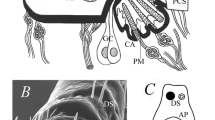Abstract
Amputation of legs in nymphs of ticks, obtained from the first laboratory generation, resulted in regeneration of the legs after moulting to adults. Haller's sensory organ on the upper surface of each foreleg tarsus was significantly modified following regeneration. Haller's organ in non-amputated legs of the experimental ticks remained unchanged, being comparable to controls.
Pored olfactory sensilla in the anterior pit, in a capsule and on a distal knoll usually increased in number, as well as grooved, thin and conical sensilla. Bordering gustatory and double-walled postcapsular sensilla either decreased or increased in number. All additional sensilla were consistent in their location. Form of the anterior pit and capsule's aperture also deeply changed after the regeneration. The authors distinguish this changes as atavistic.
No correlation between changes in different parts of the organ were found.
A phenomenon of induction was discovered in our study: if a distal part of tick's gnathosoma was amputated together with the left foreleg, Haller's organ in the right, untreated leg possessed the same changes after moulting as the regenerated organ in the previously amputated left foreleg.
Similar content being viewed by others
References
Balashov, Yu.S. and Leonovich, S.A., 1978. External ultrastructure of Haller's organ in the ticks of subfamily Ixodinae (Acarina, Ixodoidea) in connection with the systematics of the group. In: Fine structural Peculiarities of Terrestrial Arthropods. Zool. Inst. Proceedings, 77: 29–36 (in Russian).
Belozerov, V.N., 1992. Limb regeneration in ixodid ticks. Parasitologiya, in press.
Edwards, J.S., 1988. Sensory regeneration in arthropods: implications of homoeosis and of ectopic sensilla. Am. Zool., 28: 1155–1164.
Foelix, R.F. and Axtell, R.C., 1972. Ultrastructure of Haller's organ in the tickAmblyomma americanum (L.). Z. Zellforsch., 124: 275–292.
Goss, R.J., 1969. Principles of Regeneration. Academic Press, New York, NY, 287 pp.
Hess, E. and Vlimant, M., 1982. The tarsal sensory system ofAmblyomma variegatum Fabricius (Ixodidae, Metastriata). 1. Wall pore and terminal pore sensilla. Rev. Suisse Zool., 89: 713–729.
Leonovich, S.A., 1977. Electron microscopy studies of Haller's organ in the tickIxodes persulcatus (Ixodidae). Parasitologiya, 11: 340–347 (in Russian).
Leonovich, S.A., 1978. Fine structure of Haller's organ in the ixodid tickHyalomma asiaticum (Parasitiformes, Ixodidae, Amblyomminae). Entomol. Obozr., 57: 221–226 (in Russian).
Leonovich, S.A., 1985. Sense organs. In: Taiga tickIxodes persulcatus Schulze (Acarina, Ixodidae). Morphology, Systematics, Ecology, Medical Importance. Nauka Publishers, Leningrad, pp. 77–83 (in Russian).
Leonovich, S.A., 1987. The search receptors of blood-sucking ticks and mites (Parasitiformes). Parasitol. Sb., 34: 83–96 (in Russian).
Nuttall, G.H.F., 1920. Regeneration of the mouth parts and legs in ticks. Parasitology, 12: 7–26.
Rockett, C.L. and Woodring, J.P., 1972. Comparative studies of acarine limb regeneration, apolysis and ecdysis. J. Insect Physiol., 18: 2319–2336.
Steinbrecht, R.A., 1989. The fine structure of thermo-hygrosensitive sensilla in the silkmothBombyx mori: receptor membrane substructure and sensory cell contacts. Cell Tissue Res., 255: 49–57.
Author information
Authors and Affiliations
Rights and permissions
About this article
Cite this article
Leonovich, S.A., Belozerov, V.N. Regeneration of Haller's sensory organ in the tickIxodes ricinus L.. Exp Appl Acarol 15, 59–79 (1992). https://doi.org/10.1007/BF01193968
Accepted:
Issue Date:
DOI: https://doi.org/10.1007/BF01193968




